Exploring Theories, Principles, and Models for Inspirational Teaching
VerifiedAdded on 2023/06/10
|22
|5383
|456
Report
AI Summary
This report delves into the theories, principles, and models essential for achieving inspirational teaching and learning. It analyzes learning preferences through cognitive, behaviorism, and constructivism theories, alongside Honey & Mumford learning styles, and VARK model. The report discusses the application of these theories and models in teaching, learning, and assessment, emphasizing the importance of inclusive teaching by catering to individual learning preferences. It further explores assessment theories and curriculum development models, explaining their application in assessing learning and developing effective curricula. Finally, the report examines reflection and evaluation theories, demonstrating their use in reviewing and improving teaching practices. This document is available on Desklib, where students can find a variety of study resources including past papers and solved assignments.
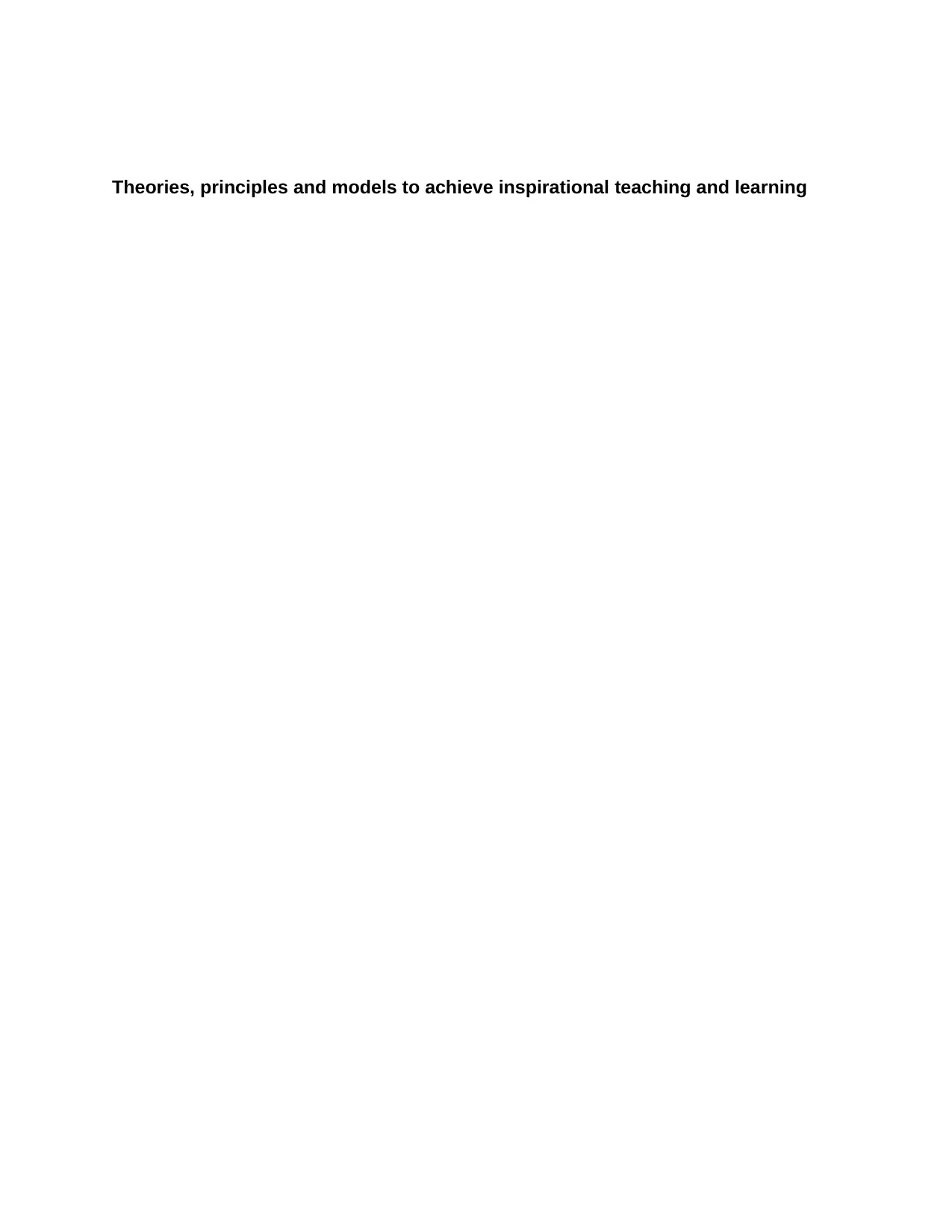
Theories, principles and models to achieve inspirational teaching and learning
Paraphrase This Document
Need a fresh take? Get an instant paraphrase of this document with our AI Paraphraser
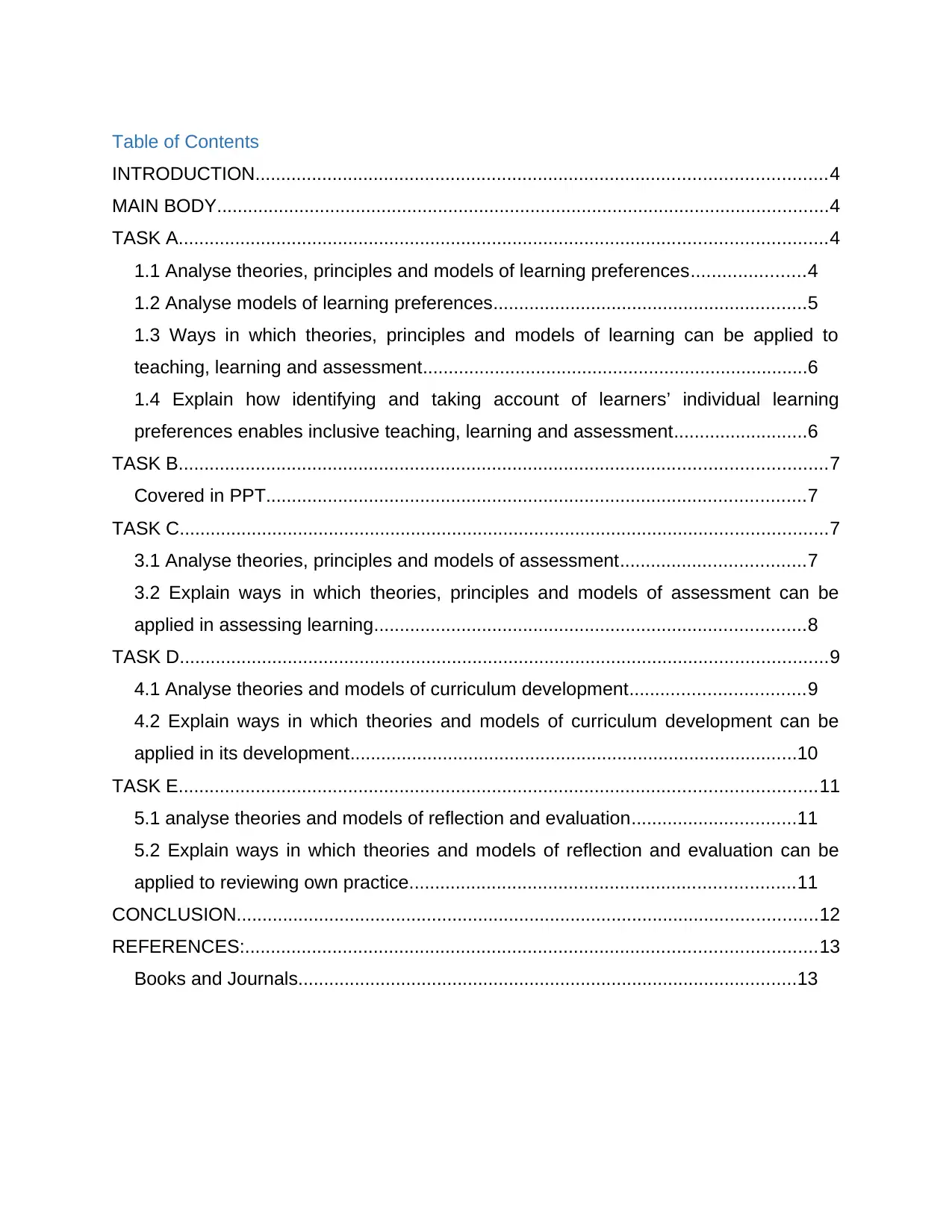
Table of Contents
INTRODUCTION...............................................................................................................4
MAIN BODY.......................................................................................................................4
TASK A..............................................................................................................................4
1.1 Analyse theories, principles and models of learning preferences......................4
1.2 Analyse models of learning preferences.............................................................5
1.3 Ways in which theories, principles and models of learning can be applied to
teaching, learning and assessment...........................................................................6
1.4 Explain how identifying and taking account of learners’ individual learning
preferences enables inclusive teaching, learning and assessment..........................6
TASK B..............................................................................................................................7
Covered in PPT.........................................................................................................7
TASK C..............................................................................................................................7
3.1 Analyse theories, principles and models of assessment....................................7
3.2 Explain ways in which theories, principles and models of assessment can be
applied in assessing learning....................................................................................8
TASK D..............................................................................................................................9
4.1 Analyse theories and models of curriculum development..................................9
4.2 Explain ways in which theories and models of curriculum development can be
applied in its development.......................................................................................10
TASK E............................................................................................................................11
5.1 analyse theories and models of reflection and evaluation................................11
5.2 Explain ways in which theories and models of reflection and evaluation can be
applied to reviewing own practice...........................................................................11
CONCLUSION.................................................................................................................12
REFERENCES:...............................................................................................................13
Books and Journals.................................................................................................13
INTRODUCTION...............................................................................................................4
MAIN BODY.......................................................................................................................4
TASK A..............................................................................................................................4
1.1 Analyse theories, principles and models of learning preferences......................4
1.2 Analyse models of learning preferences.............................................................5
1.3 Ways in which theories, principles and models of learning can be applied to
teaching, learning and assessment...........................................................................6
1.4 Explain how identifying and taking account of learners’ individual learning
preferences enables inclusive teaching, learning and assessment..........................6
TASK B..............................................................................................................................7
Covered in PPT.........................................................................................................7
TASK C..............................................................................................................................7
3.1 Analyse theories, principles and models of assessment....................................7
3.2 Explain ways in which theories, principles and models of assessment can be
applied in assessing learning....................................................................................8
TASK D..............................................................................................................................9
4.1 Analyse theories and models of curriculum development..................................9
4.2 Explain ways in which theories and models of curriculum development can be
applied in its development.......................................................................................10
TASK E............................................................................................................................11
5.1 analyse theories and models of reflection and evaluation................................11
5.2 Explain ways in which theories and models of reflection and evaluation can be
applied to reviewing own practice...........................................................................11
CONCLUSION.................................................................................................................12
REFERENCES:...............................................................................................................13
Books and Journals.................................................................................................13
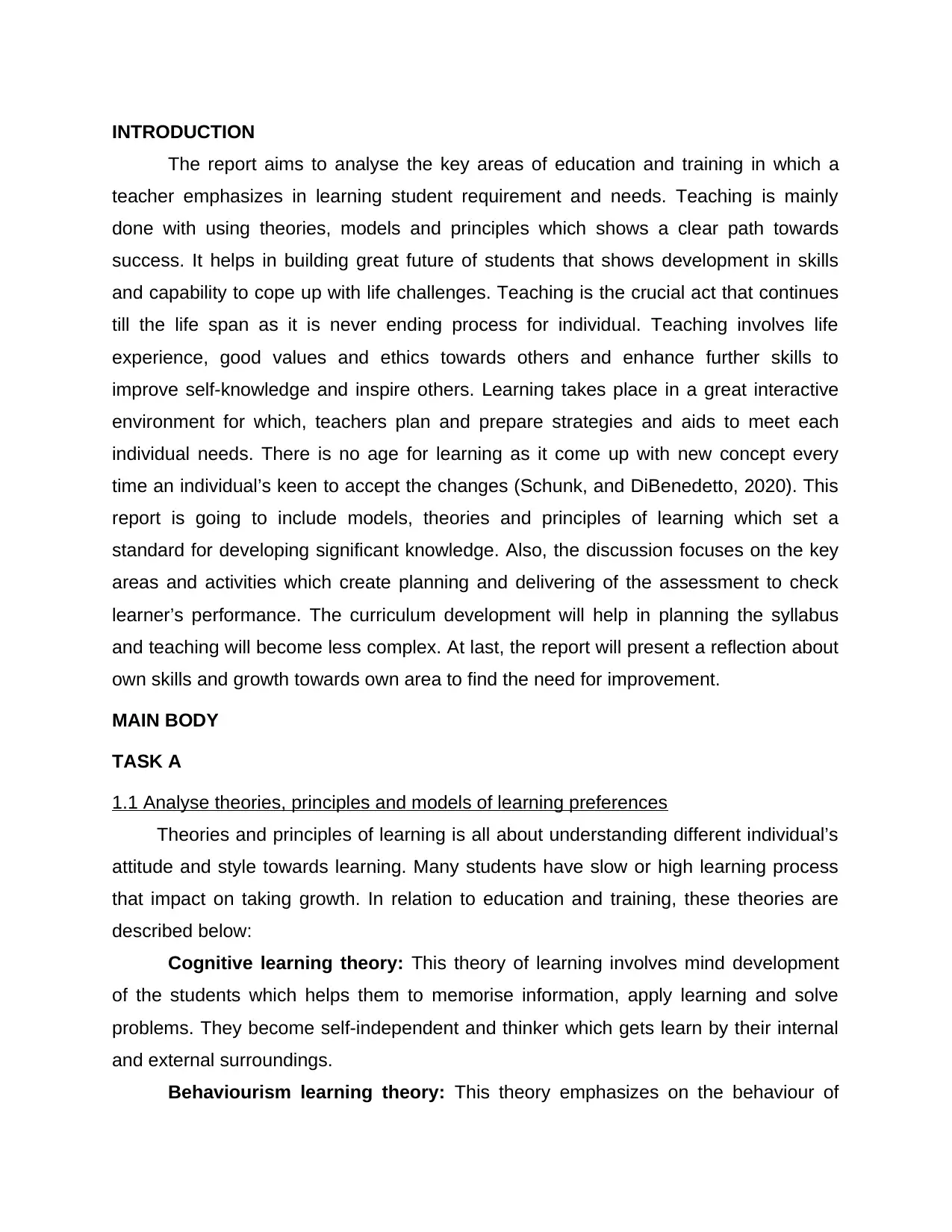
INTRODUCTION
The report aims to analyse the key areas of education and training in which a
teacher emphasizes in learning student requirement and needs. Teaching is mainly
done with using theories, models and principles which shows a clear path towards
success. It helps in building great future of students that shows development in skills
and capability to cope up with life challenges. Teaching is the crucial act that continues
till the life span as it is never ending process for individual. Teaching involves life
experience, good values and ethics towards others and enhance further skills to
improve self-knowledge and inspire others. Learning takes place in a great interactive
environment for which, teachers plan and prepare strategies and aids to meet each
individual needs. There is no age for learning as it come up with new concept every
time an individual’s keen to accept the changes (Schunk, and DiBenedetto, 2020). This
report is going to include models, theories and principles of learning which set a
standard for developing significant knowledge. Also, the discussion focuses on the key
areas and activities which create planning and delivering of the assessment to check
learner’s performance. The curriculum development will help in planning the syllabus
and teaching will become less complex. At last, the report will present a reflection about
own skills and growth towards own area to find the need for improvement.
MAIN BODY
TASK A
1.1 Analyse theories, principles and models of learning preferences
Theories and principles of learning is all about understanding different individual’s
attitude and style towards learning. Many students have slow or high learning process
that impact on taking growth. In relation to education and training, these theories are
described below:
Cognitive learning theory: This theory of learning involves mind development
of the students which helps them to memorise information, apply learning and solve
problems. They become self-independent and thinker which gets learn by their internal
and external surroundings.
Behaviourism learning theory: This theory emphasizes on the behaviour of
The report aims to analyse the key areas of education and training in which a
teacher emphasizes in learning student requirement and needs. Teaching is mainly
done with using theories, models and principles which shows a clear path towards
success. It helps in building great future of students that shows development in skills
and capability to cope up with life challenges. Teaching is the crucial act that continues
till the life span as it is never ending process for individual. Teaching involves life
experience, good values and ethics towards others and enhance further skills to
improve self-knowledge and inspire others. Learning takes place in a great interactive
environment for which, teachers plan and prepare strategies and aids to meet each
individual needs. There is no age for learning as it come up with new concept every
time an individual’s keen to accept the changes (Schunk, and DiBenedetto, 2020). This
report is going to include models, theories and principles of learning which set a
standard for developing significant knowledge. Also, the discussion focuses on the key
areas and activities which create planning and delivering of the assessment to check
learner’s performance. The curriculum development will help in planning the syllabus
and teaching will become less complex. At last, the report will present a reflection about
own skills and growth towards own area to find the need for improvement.
MAIN BODY
TASK A
1.1 Analyse theories, principles and models of learning preferences
Theories and principles of learning is all about understanding different individual’s
attitude and style towards learning. Many students have slow or high learning process
that impact on taking growth. In relation to education and training, these theories are
described below:
Cognitive learning theory: This theory of learning involves mind development
of the students which helps them to memorise information, apply learning and solve
problems. They become self-independent and thinker which gets learn by their internal
and external surroundings.
Behaviourism learning theory: This theory emphasizes on the behaviour of
⊘ This is a preview!⊘
Do you want full access?
Subscribe today to unlock all pages.

Trusted by 1+ million students worldwide
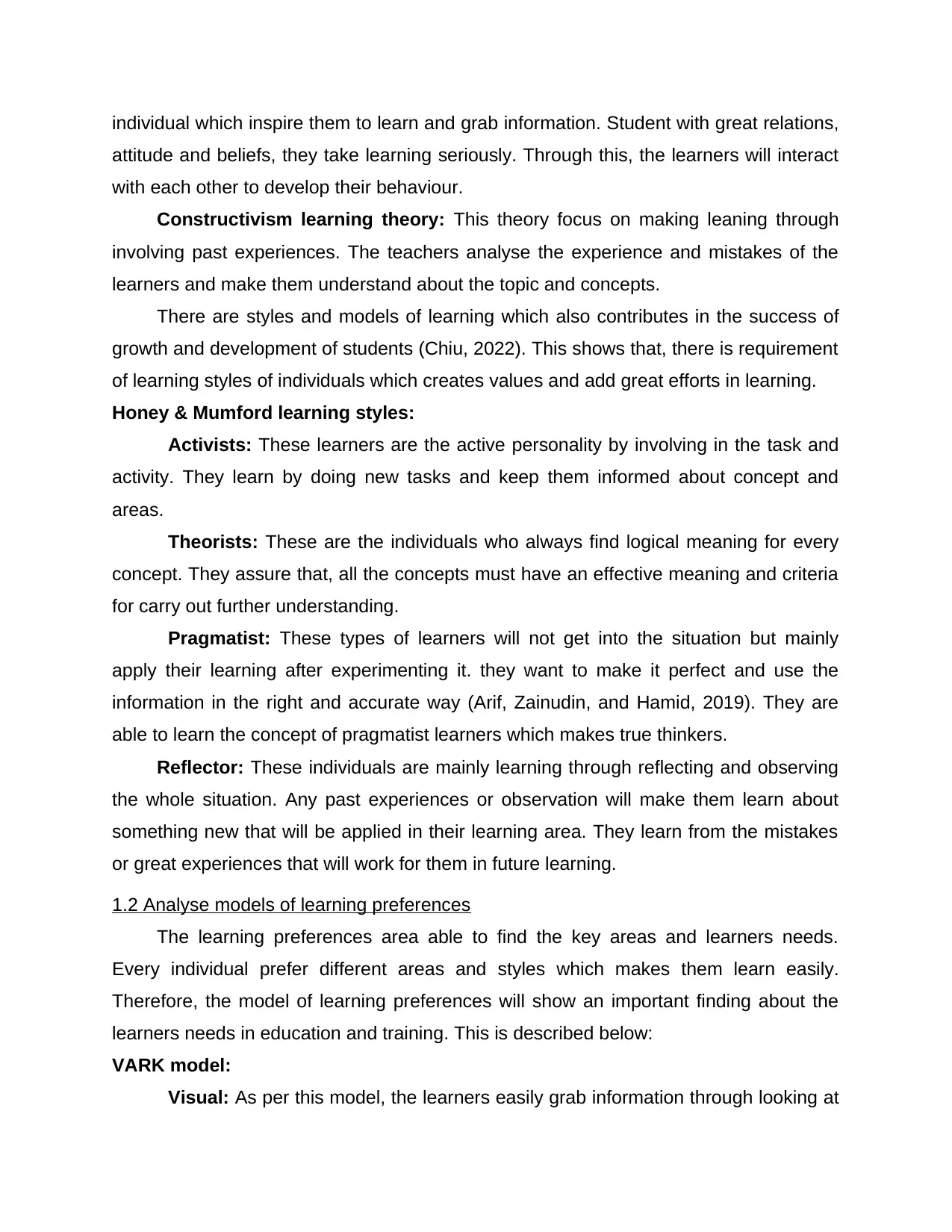
individual which inspire them to learn and grab information. Student with great relations,
attitude and beliefs, they take learning seriously. Through this, the learners will interact
with each other to develop their behaviour.
Constructivism learning theory: This theory focus on making leaning through
involving past experiences. The teachers analyse the experience and mistakes of the
learners and make them understand about the topic and concepts.
There are styles and models of learning which also contributes in the success of
growth and development of students (Chiu, 2022). This shows that, there is requirement
of learning styles of individuals which creates values and add great efforts in learning.
Honey & Mumford learning styles:
Activists: These learners are the active personality by involving in the task and
activity. They learn by doing new tasks and keep them informed about concept and
areas.
Theorists: These are the individuals who always find logical meaning for every
concept. They assure that, all the concepts must have an effective meaning and criteria
for carry out further understanding.
Pragmatist: These types of learners will not get into the situation but mainly
apply their learning after experimenting it. they want to make it perfect and use the
information in the right and accurate way (Arif, Zainudin, and Hamid, 2019). They are
able to learn the concept of pragmatist learners which makes true thinkers.
Reflector: These individuals are mainly learning through reflecting and observing
the whole situation. Any past experiences or observation will make them learn about
something new that will be applied in their learning area. They learn from the mistakes
or great experiences that will work for them in future learning.
1.2 Analyse models of learning preferences
The learning preferences area able to find the key areas and learners needs.
Every individual prefer different areas and styles which makes them learn easily.
Therefore, the model of learning preferences will show an important finding about the
learners needs in education and training. This is described below:
VARK model:
Visual: As per this model, the learners easily grab information through looking at
attitude and beliefs, they take learning seriously. Through this, the learners will interact
with each other to develop their behaviour.
Constructivism learning theory: This theory focus on making leaning through
involving past experiences. The teachers analyse the experience and mistakes of the
learners and make them understand about the topic and concepts.
There are styles and models of learning which also contributes in the success of
growth and development of students (Chiu, 2022). This shows that, there is requirement
of learning styles of individuals which creates values and add great efforts in learning.
Honey & Mumford learning styles:
Activists: These learners are the active personality by involving in the task and
activity. They learn by doing new tasks and keep them informed about concept and
areas.
Theorists: These are the individuals who always find logical meaning for every
concept. They assure that, all the concepts must have an effective meaning and criteria
for carry out further understanding.
Pragmatist: These types of learners will not get into the situation but mainly
apply their learning after experimenting it. they want to make it perfect and use the
information in the right and accurate way (Arif, Zainudin, and Hamid, 2019). They are
able to learn the concept of pragmatist learners which makes true thinkers.
Reflector: These individuals are mainly learning through reflecting and observing
the whole situation. Any past experiences or observation will make them learn about
something new that will be applied in their learning area. They learn from the mistakes
or great experiences that will work for them in future learning.
1.2 Analyse models of learning preferences
The learning preferences area able to find the key areas and learners needs.
Every individual prefer different areas and styles which makes them learn easily.
Therefore, the model of learning preferences will show an important finding about the
learners needs in education and training. This is described below:
VARK model:
Visual: As per this model, the learners easily grab information through looking at
Paraphrase This Document
Need a fresh take? Get an instant paraphrase of this document with our AI Paraphraser
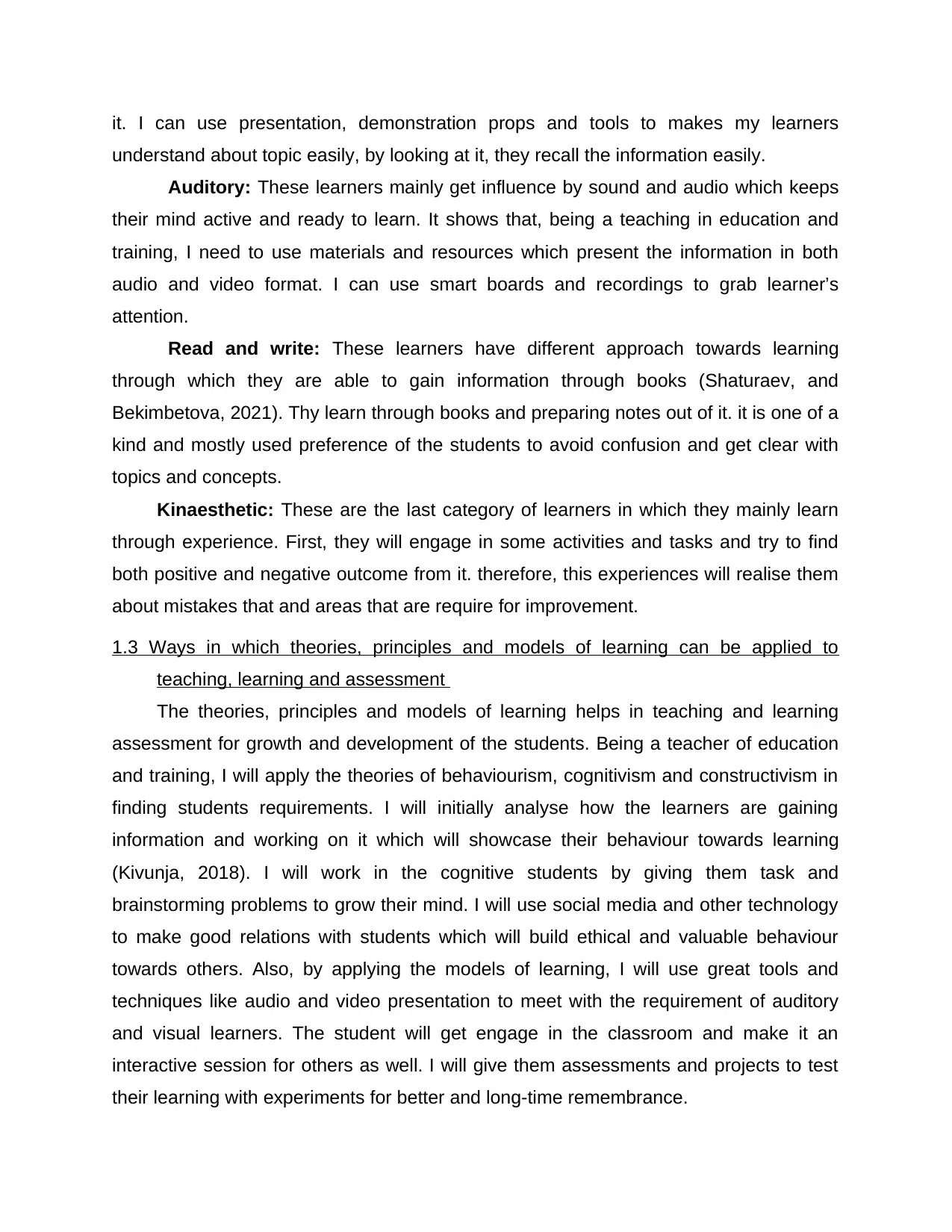
it. I can use presentation, demonstration props and tools to makes my learners
understand about topic easily, by looking at it, they recall the information easily.
Auditory: These learners mainly get influence by sound and audio which keeps
their mind active and ready to learn. It shows that, being a teaching in education and
training, I need to use materials and resources which present the information in both
audio and video format. I can use smart boards and recordings to grab learner’s
attention.
Read and write: These learners have different approach towards learning
through which they are able to gain information through books (Shaturaev, and
Bekimbetova, 2021). Thy learn through books and preparing notes out of it. it is one of a
kind and mostly used preference of the students to avoid confusion and get clear with
topics and concepts.
Kinaesthetic: These are the last category of learners in which they mainly learn
through experience. First, they will engage in some activities and tasks and try to find
both positive and negative outcome from it. therefore, this experiences will realise them
about mistakes that and areas that are require for improvement.
1.3 Ways in which theories, principles and models of learning can be applied to
teaching, learning and assessment
The theories, principles and models of learning helps in teaching and learning
assessment for growth and development of the students. Being a teacher of education
and training, I will apply the theories of behaviourism, cognitivism and constructivism in
finding students requirements. I will initially analyse how the learners are gaining
information and working on it which will showcase their behaviour towards learning
(Kivunja, 2018). I will work in the cognitive students by giving them task and
brainstorming problems to grow their mind. I will use social media and other technology
to make good relations with students which will build ethical and valuable behaviour
towards others. Also, by applying the models of learning, I will use great tools and
techniques like audio and video presentation to meet with the requirement of auditory
and visual learners. The student will get engage in the classroom and make it an
interactive session for others as well. I will give them assessments and projects to test
their learning with experiments for better and long-time remembrance.
understand about topic easily, by looking at it, they recall the information easily.
Auditory: These learners mainly get influence by sound and audio which keeps
their mind active and ready to learn. It shows that, being a teaching in education and
training, I need to use materials and resources which present the information in both
audio and video format. I can use smart boards and recordings to grab learner’s
attention.
Read and write: These learners have different approach towards learning
through which they are able to gain information through books (Shaturaev, and
Bekimbetova, 2021). Thy learn through books and preparing notes out of it. it is one of a
kind and mostly used preference of the students to avoid confusion and get clear with
topics and concepts.
Kinaesthetic: These are the last category of learners in which they mainly learn
through experience. First, they will engage in some activities and tasks and try to find
both positive and negative outcome from it. therefore, this experiences will realise them
about mistakes that and areas that are require for improvement.
1.3 Ways in which theories, principles and models of learning can be applied to
teaching, learning and assessment
The theories, principles and models of learning helps in teaching and learning
assessment for growth and development of the students. Being a teacher of education
and training, I will apply the theories of behaviourism, cognitivism and constructivism in
finding students requirements. I will initially analyse how the learners are gaining
information and working on it which will showcase their behaviour towards learning
(Kivunja, 2018). I will work in the cognitive students by giving them task and
brainstorming problems to grow their mind. I will use social media and other technology
to make good relations with students which will build ethical and valuable behaviour
towards others. Also, by applying the models of learning, I will use great tools and
techniques like audio and video presentation to meet with the requirement of auditory
and visual learners. The student will get engage in the classroom and make it an
interactive session for others as well. I will give them assessments and projects to test
their learning with experiments for better and long-time remembrance.
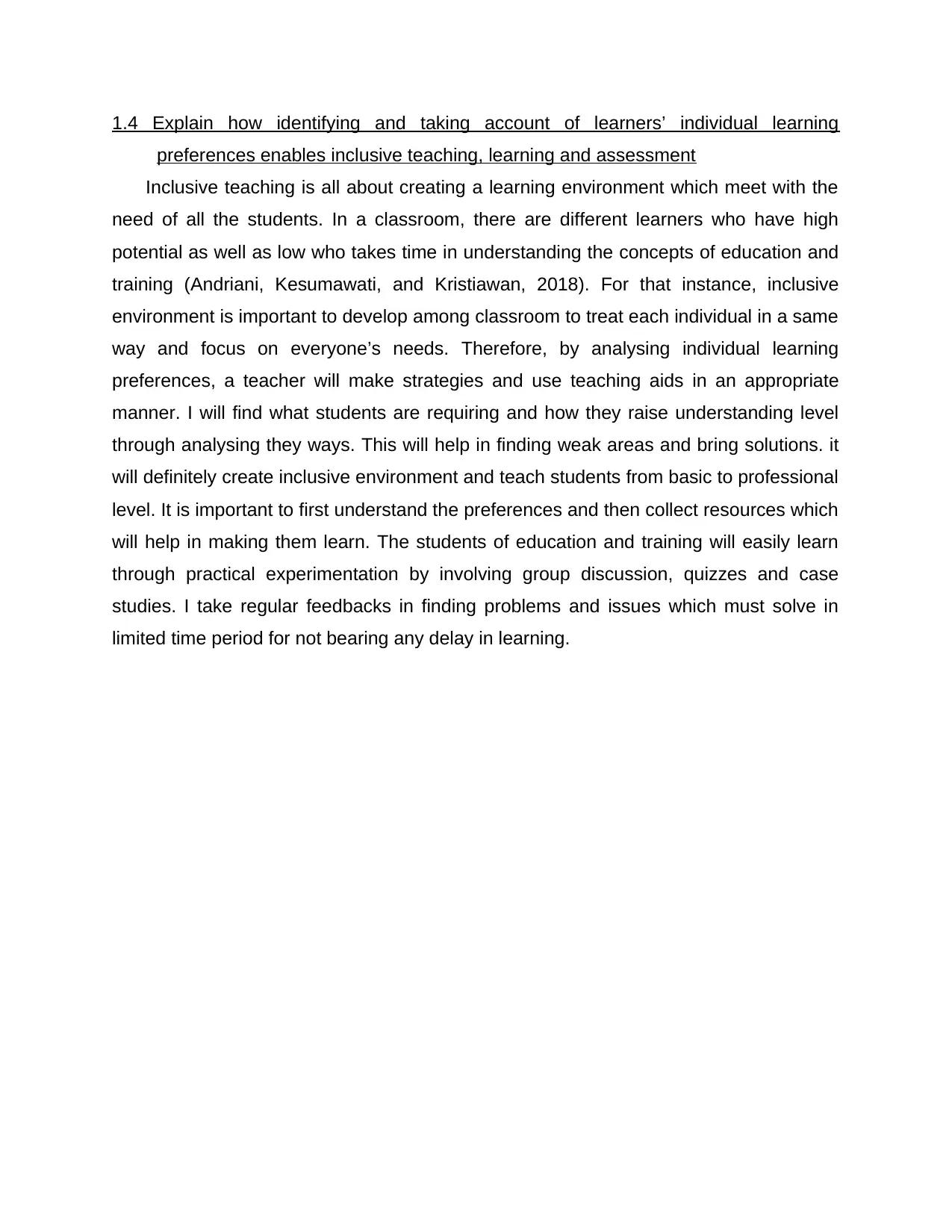
1.4 Explain how identifying and taking account of learners’ individual learning
preferences enables inclusive teaching, learning and assessment
Inclusive teaching is all about creating a learning environment which meet with the
need of all the students. In a classroom, there are different learners who have high
potential as well as low who takes time in understanding the concepts of education and
training (Andriani, Kesumawati, and Kristiawan, 2018). For that instance, inclusive
environment is important to develop among classroom to treat each individual in a same
way and focus on everyone’s needs. Therefore, by analysing individual learning
preferences, a teacher will make strategies and use teaching aids in an appropriate
manner. I will find what students are requiring and how they raise understanding level
through analysing they ways. This will help in finding weak areas and bring solutions. it
will definitely create inclusive environment and teach students from basic to professional
level. It is important to first understand the preferences and then collect resources which
will help in making them learn. The students of education and training will easily learn
through practical experimentation by involving group discussion, quizzes and case
studies. I take regular feedbacks in finding problems and issues which must solve in
limited time period for not bearing any delay in learning.
preferences enables inclusive teaching, learning and assessment
Inclusive teaching is all about creating a learning environment which meet with the
need of all the students. In a classroom, there are different learners who have high
potential as well as low who takes time in understanding the concepts of education and
training (Andriani, Kesumawati, and Kristiawan, 2018). For that instance, inclusive
environment is important to develop among classroom to treat each individual in a same
way and focus on everyone’s needs. Therefore, by analysing individual learning
preferences, a teacher will make strategies and use teaching aids in an appropriate
manner. I will find what students are requiring and how they raise understanding level
through analysing they ways. This will help in finding weak areas and bring solutions. it
will definitely create inclusive environment and teach students from basic to professional
level. It is important to first understand the preferences and then collect resources which
will help in making them learn. The students of education and training will easily learn
through practical experimentation by involving group discussion, quizzes and case
studies. I take regular feedbacks in finding problems and issues which must solve in
limited time period for not bearing any delay in learning.
⊘ This is a preview!⊘
Do you want full access?
Subscribe today to unlock all pages.

Trusted by 1+ million students worldwide
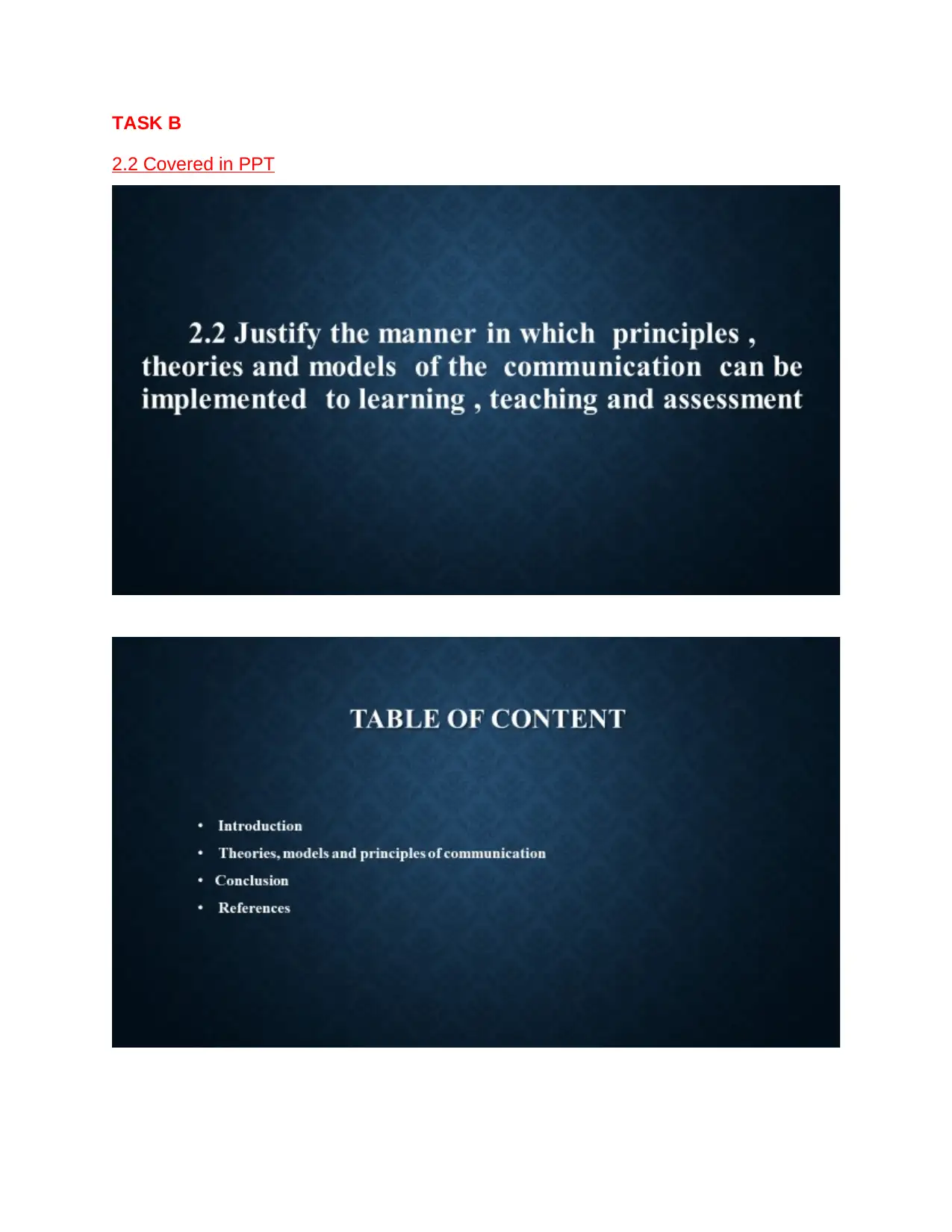
TASK B
2.2 Covered in PPT
2.2 Covered in PPT
Paraphrase This Document
Need a fresh take? Get an instant paraphrase of this document with our AI Paraphraser
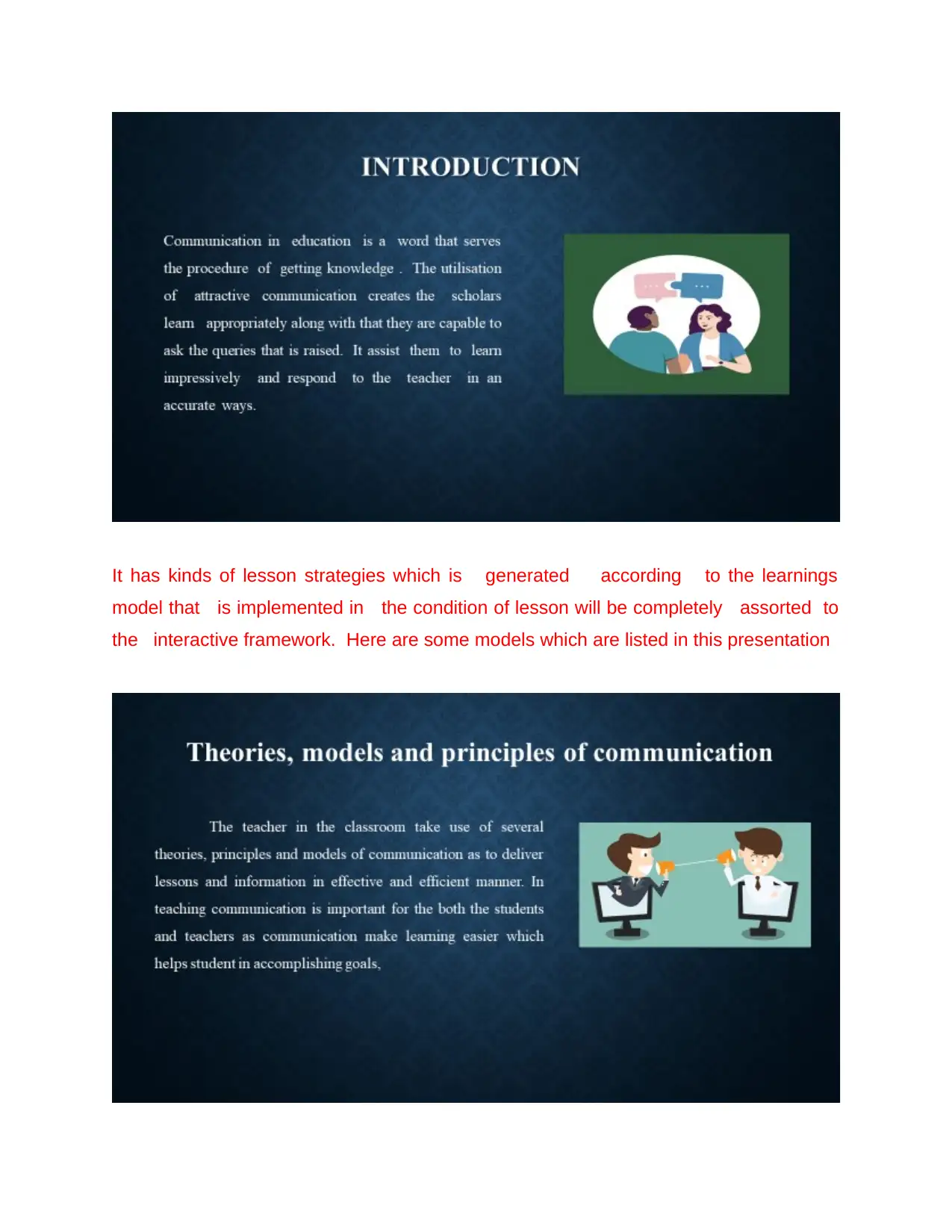
It has kinds of lesson strategies which is generated according to the learnings
model that is implemented in the condition of lesson will be completely assorted to
the interactive framework. Here are some models which are listed in this presentation
model that is implemented in the condition of lesson will be completely assorted to
the interactive framework. Here are some models which are listed in this presentation
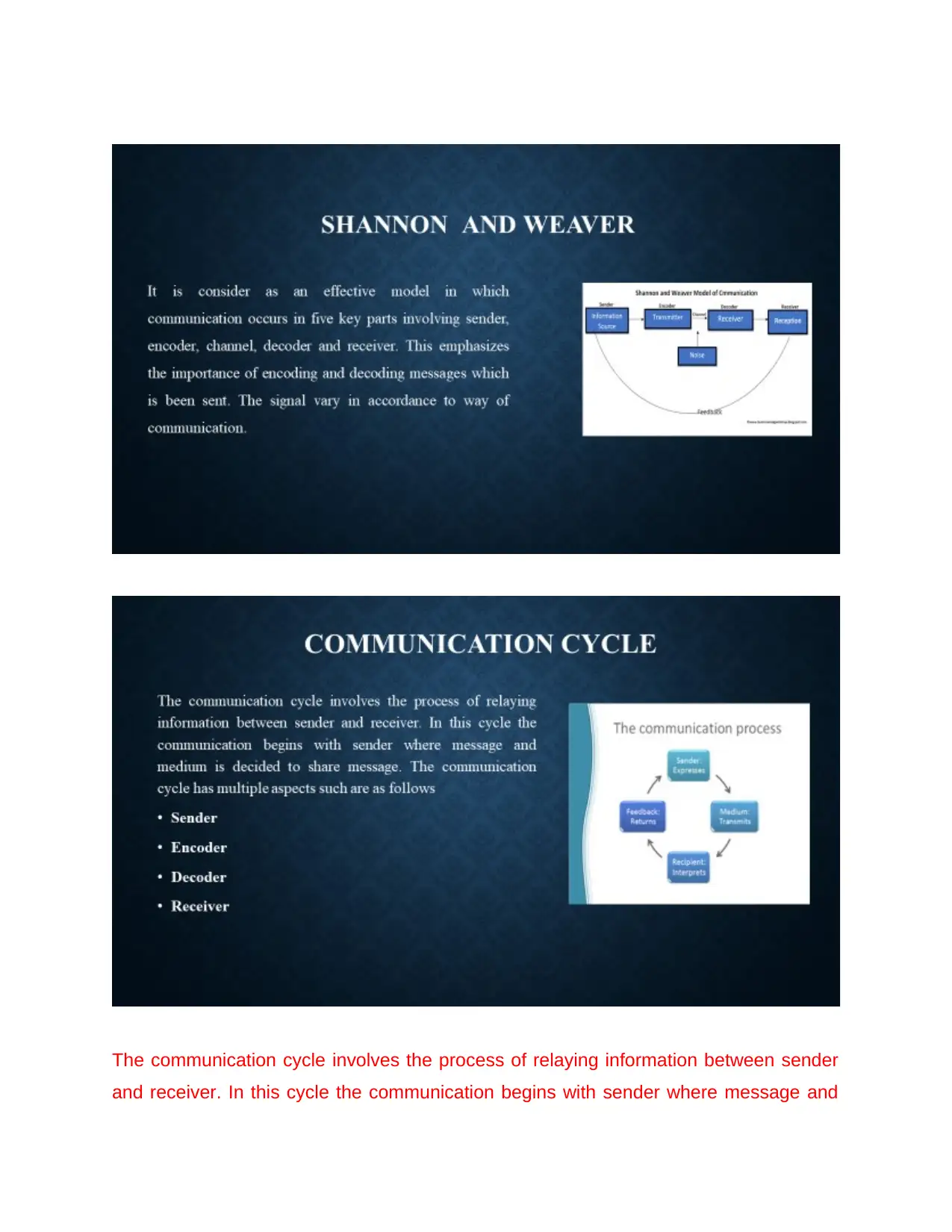
The communication cycle involves the process of relaying information between sender
and receiver. In this cycle the communication begins with sender where message and
and receiver. In this cycle the communication begins with sender where message and
⊘ This is a preview!⊘
Do you want full access?
Subscribe today to unlock all pages.

Trusted by 1+ million students worldwide
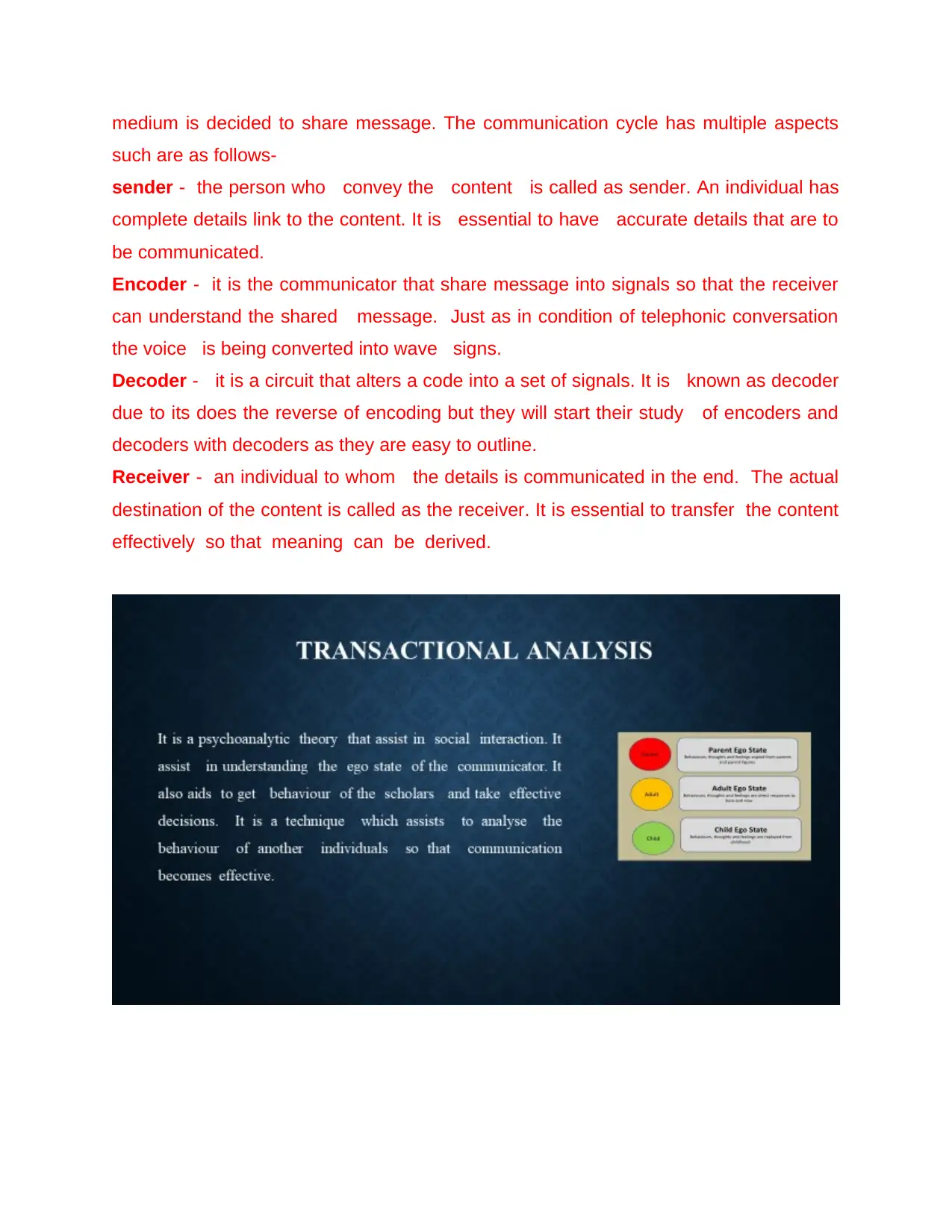
medium is decided to share message. The communication cycle has multiple aspects
such are as follows-
sender - the person who convey the content is called as sender. An individual has
complete details link to the content. It is essential to have accurate details that are to
be communicated.
Encoder - it is the communicator that share message into signals so that the receiver
can understand the shared message. Just as in condition of telephonic conversation
the voice is being converted into wave signs.
Decoder - it is a circuit that alters a code into a set of signals. It is known as decoder
due to its does the reverse of encoding but they will start their study of encoders and
decoders with decoders as they are easy to outline.
Receiver - an individual to whom the details is communicated in the end. The actual
destination of the content is called as the receiver. It is essential to transfer the content
effectively so that meaning can be derived.
such are as follows-
sender - the person who convey the content is called as sender. An individual has
complete details link to the content. It is essential to have accurate details that are to
be communicated.
Encoder - it is the communicator that share message into signals so that the receiver
can understand the shared message. Just as in condition of telephonic conversation
the voice is being converted into wave signs.
Decoder - it is a circuit that alters a code into a set of signals. It is known as decoder
due to its does the reverse of encoding but they will start their study of encoders and
decoders with decoders as they are easy to outline.
Receiver - an individual to whom the details is communicated in the end. The actual
destination of the content is called as the receiver. It is essential to transfer the content
effectively so that meaning can be derived.
Paraphrase This Document
Need a fresh take? Get an instant paraphrase of this document with our AI Paraphraser
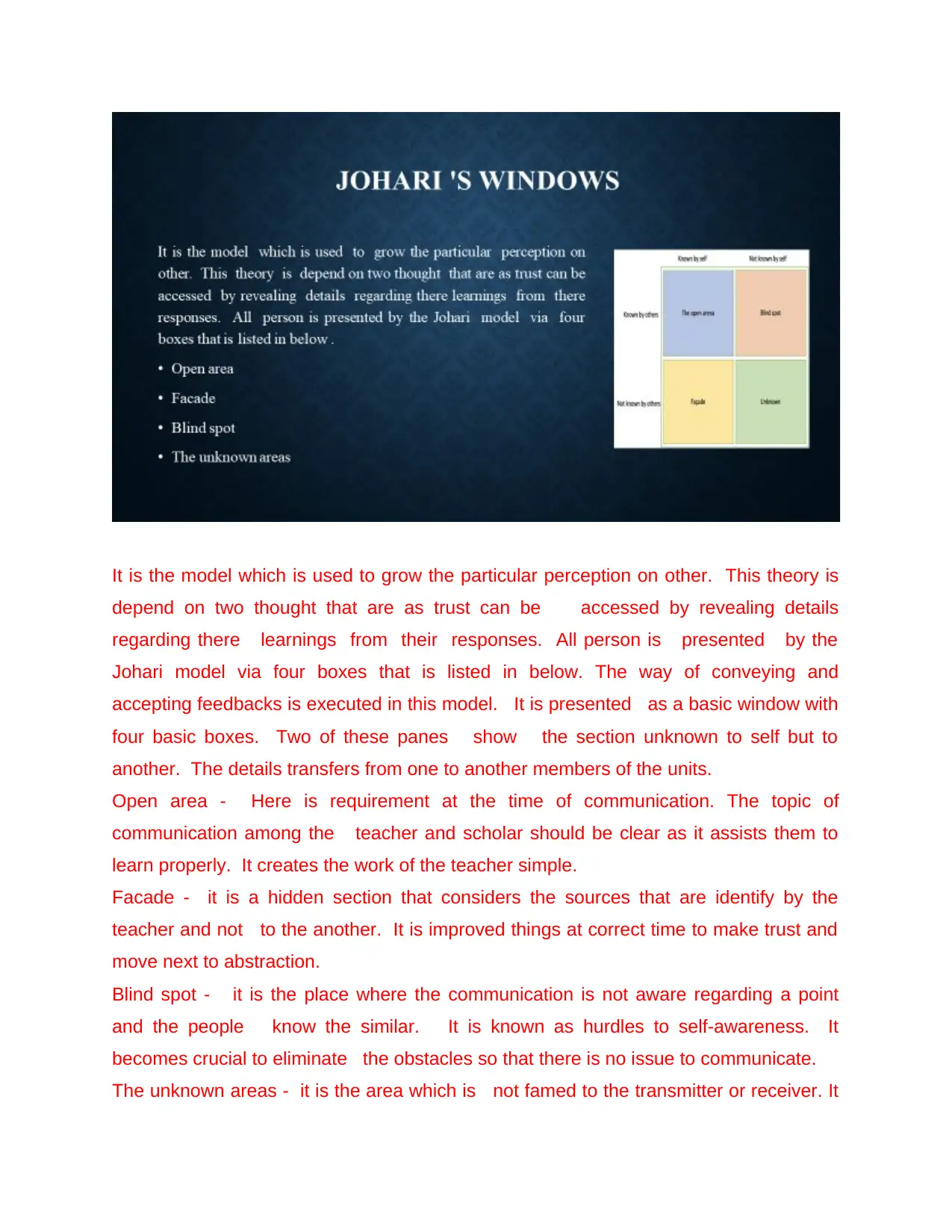
It is the model which is used to grow the particular perception on other. This theory is
depend on two thought that are as trust can be accessed by revealing details
regarding there learnings from their responses. All person is presented by the
Johari model via four boxes that is listed in below. The way of conveying and
accepting feedbacks is executed in this model. It is presented as a basic window with
four basic boxes. Two of these panes show the section unknown to self but to
another. The details transfers from one to another members of the units.
Open area - Here is requirement at the time of communication. The topic of
communication among the teacher and scholar should be clear as it assists them to
learn properly. It creates the work of the teacher simple.
Facade - it is a hidden section that considers the sources that are identify by the
teacher and not to the another. It is improved things at correct time to make trust and
move next to abstraction.
Blind spot - it is the place where the communication is not aware regarding a point
and the people know the similar. It is known as hurdles to self-awareness. It
becomes crucial to eliminate the obstacles so that there is no issue to communicate.
The unknown areas - it is the area which is not famed to the transmitter or receiver. It
depend on two thought that are as trust can be accessed by revealing details
regarding there learnings from their responses. All person is presented by the
Johari model via four boxes that is listed in below. The way of conveying and
accepting feedbacks is executed in this model. It is presented as a basic window with
four basic boxes. Two of these panes show the section unknown to self but to
another. The details transfers from one to another members of the units.
Open area - Here is requirement at the time of communication. The topic of
communication among the teacher and scholar should be clear as it assists them to
learn properly. It creates the work of the teacher simple.
Facade - it is a hidden section that considers the sources that are identify by the
teacher and not to the another. It is improved things at correct time to make trust and
move next to abstraction.
Blind spot - it is the place where the communication is not aware regarding a point
and the people know the similar. It is known as hurdles to self-awareness. It
becomes crucial to eliminate the obstacles so that there is no issue to communicate.
The unknown areas - it is the area which is not famed to the transmitter or receiver. It
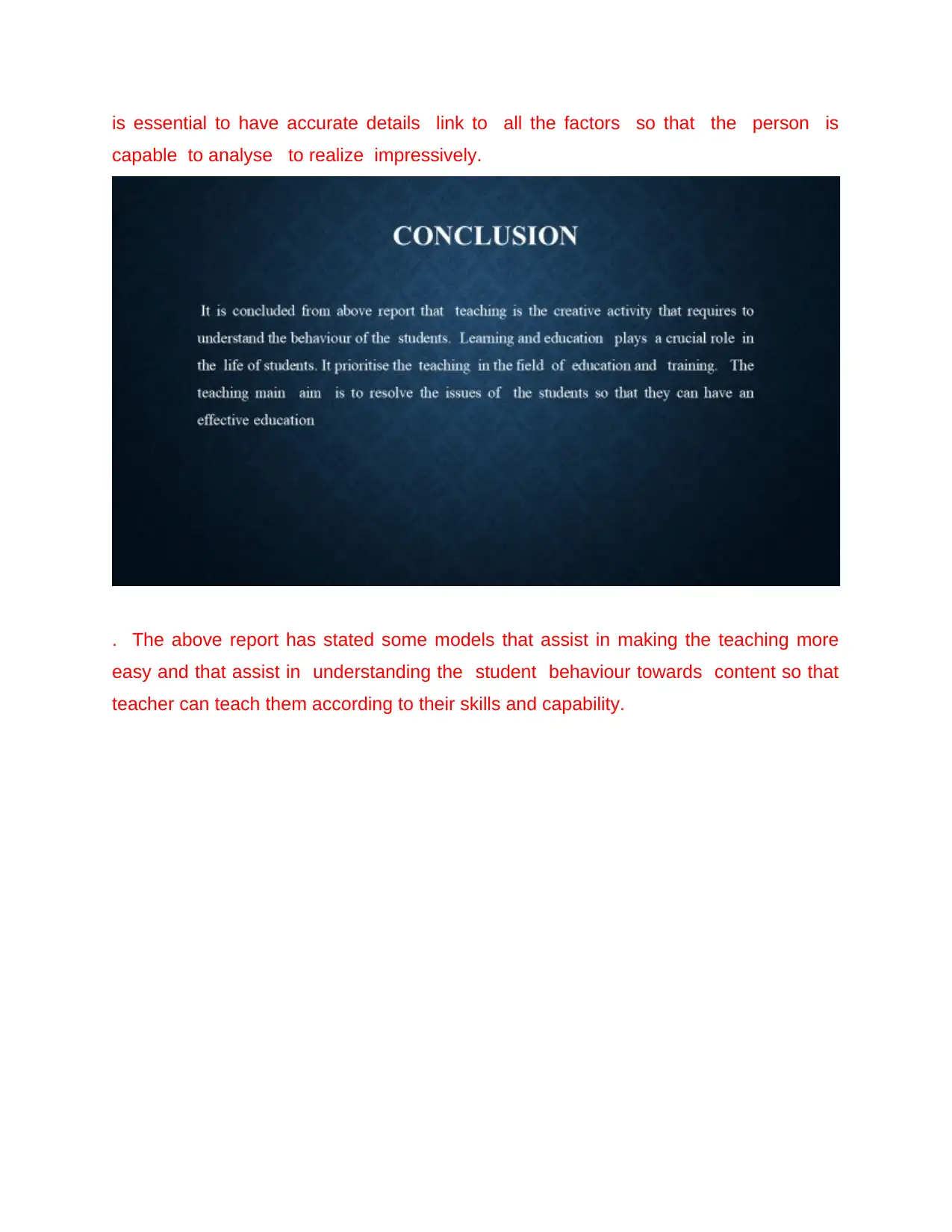
is essential to have accurate details link to all the factors so that the person is
capable to analyse to realize impressively.
. The above report has stated some models that assist in making the teaching more
easy and that assist in understanding the student behaviour towards content so that
teacher can teach them according to their skills and capability.
capable to analyse to realize impressively.
. The above report has stated some models that assist in making the teaching more
easy and that assist in understanding the student behaviour towards content so that
teacher can teach them according to their skills and capability.
⊘ This is a preview!⊘
Do you want full access?
Subscribe today to unlock all pages.

Trusted by 1+ million students worldwide
1 out of 22
Related Documents
Your All-in-One AI-Powered Toolkit for Academic Success.
+13062052269
info@desklib.com
Available 24*7 on WhatsApp / Email
![[object Object]](/_next/static/media/star-bottom.7253800d.svg)
Unlock your academic potential
Copyright © 2020–2025 A2Z Services. All Rights Reserved. Developed and managed by ZUCOL.

